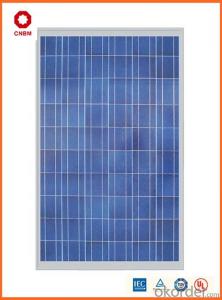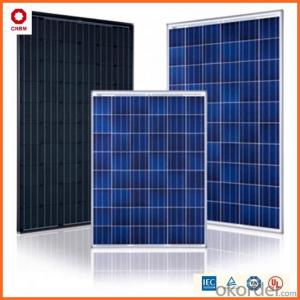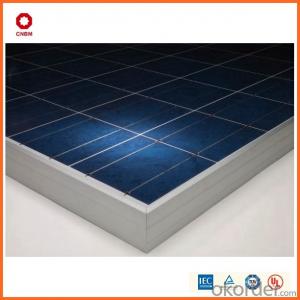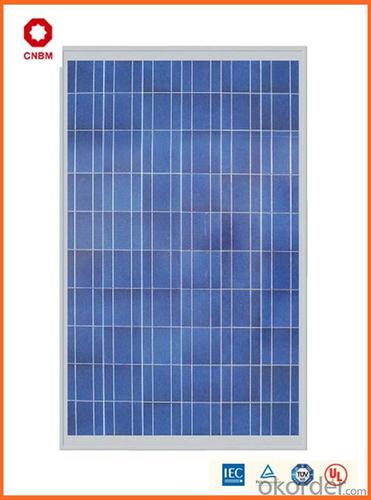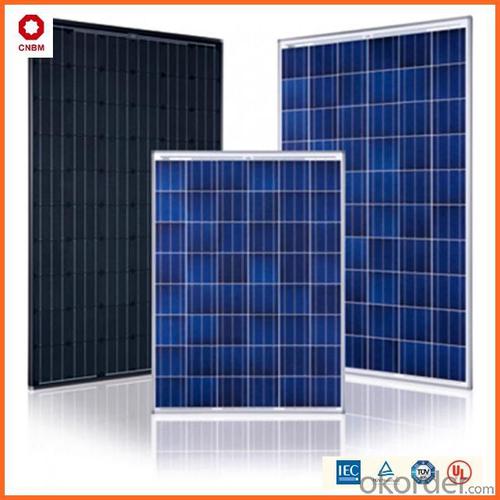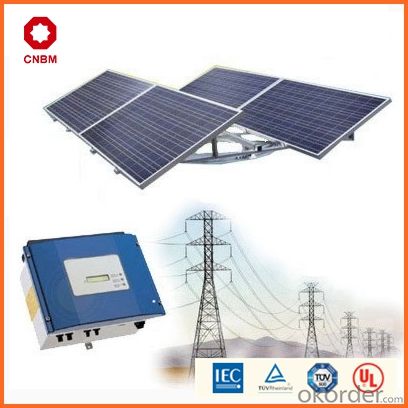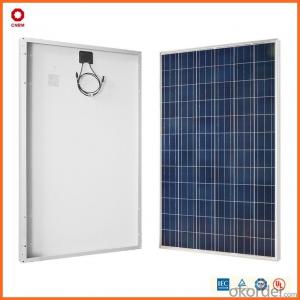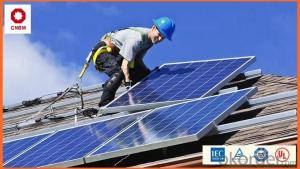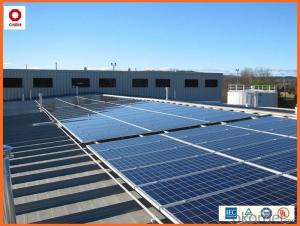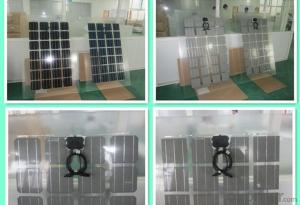30w Small Solar Panels in Stock - Solar Energy Systems Windermere - China Manufacturer
- Loading Port:
- China main port
- Payment Terms:
- TT OR LC
- Min Order Qty:
- 10 watt
- Supply Capability:
- 10000000 watt/month
OKorder Service Pledge
OKorder Financial Service
You Might Also Like
Specification
Product Description:
Hot Sale !!! Quality and Safety of Small Poly Solar Panel 5w~150w
1. Rigorous quality control meets the highest international standards.
2. High-transmissivity low-iron tempered glass, strong aluminium frame.
3. Using UV-resistant silicon.
4. IS09001/14001/CE/TUV/UL
Warranties of Small Poly Solar Panel 35~85w
1. 10 years limited product warranty
2. 15 years at 90% of the minimal rated power output
3. 25 years at 80% of the minimal rated power output
Specification
Characteristics of Poly solar panels CNBM (245-320W) | |||||
Max Power Voltage Vmp(V) | 30.3 | 30.8 | 31.1 | 31.4 | 31.85 |
Max Power Current Imp(A) | 7.60 | 7.64 | 7.73 | 7.81 | 7.85 |
Open Circuit Voltage Voc(V) | 36.1 | 36.6 | 37 | 37.3 | 37.68 |
Short Circuit Current Isc(A) | 8.50 | 8.55 | 8.65 | 8.75 | 8.85 |
Max Power Pm(W) | 230W | 235W | 240W | 245W | 250W |
Temperature Coefficient of Cells Poly solar panels CNBM (245-320W) | |
NOCT | 45± 2 |
Temperature Coeffucients of Isc | 0.0492 |
Temperature Coeffucients of Voc | -0.3374 |
Temperature Coeffucients of Voc | -0.4677 |
Mechanical Data of Poly solar panels CNBM (245-320W) | |
Dimension | 1638 × 982 × 40 mm |
Weight | 19.5 kg |
No. of Cells and Connections | 60 (6 ×10) |
Tolerance | 0 ~ + 5 W |
Cell | Monocrystalline Cell 156 × 156 mm |
Packing | 624 Pcs/40ft(H) Container |
Limits of Poly solar panels CNBM (245-320W) | |
Operating Temperature | -40 to +85 |
Storage Temperature | -40 to +85 |
Max System Voltage | 1000VDC(IEC) / 600VDC(UL) |
Features of our products:
• High conversion efficiency mono/poly-crystalline amorphous silicon solar cells
• Modules incorporate high performance bypass diodes to minimize the power drop caused by shading
• High transmittance, low-iron tempered glass
• High performance EVA encapsulant to prevent destroying and water.
• AI frame: without screw, corner connection. 8 holes on the frame can be installed easily
• Good performance of preventing from atrocious weather such as wind and hails
• Certifications: CE IEC TUV VDE UL, Class I
• 10 years 90% power output warranty

Shipping of Small Poly Solar Panel 35~85w
By Sea | Delivery from Shanghai or Ningbo seaport |
By Air | Departure from Shanghai Pudong Airport |
By Express | Post by DHL, EMS, UPS, TNT. |
Features of our products:
• High conversion efficiency mono/poly-crystalline amorphous silicon solar cells
• Modules incorporate high performance bypass diodes to minimize the power drop caused by shading
• High transmittance, low-iron tempered glass
• High performance EVA encapsulant to prevent destroying and water.
• AI frame: without screw, corner connection. 8 holes on the frame can be installed easily
• Good performance of preventing from atrocious weather such as wind and hails
• Certifications: CE IEC TUV VDE UL, Class I
• 10 years 90% power output warranty
As a professional Solar Panel manufacturer and Supplier in China, we have our customers come around the whole world and our specialization has got a worldwide recognition. Meanwhile, with our superior quality, competitive price, prompt and excellent service, As main role in trade section of CNBM Group, CNBM International Corporation supplies products including Monocrystalline Solar Panel, Polycrystalline Solar Panel ( multicrystalline silicon Solar Panel) have received and enjoyed famous reputation in many countries and regions in the world.
- Q: Can solar energy systems be used for water heating in swimming pools or hot tubs?
- Yes, solar energy systems can be used for water heating in swimming pools or hot tubs. Solar thermal collectors capture the sun's energy and transfer it to the water, providing an efficient and cost-effective way to heat the water in pools and hot tubs. These systems can significantly reduce energy consumption and operating costs, making them a popular choice for environmentally friendly and sustainable water heating.
- Q: What is the role of solar trackers in maximizing solar energy generation?
- Solar trackers play a crucial role in maximizing solar energy generation by continuously adjusting the position of solar panels to track the movement of the sun throughout the day. This ensures that the panels are always oriented towards the sun at the most optimal angle, maximizing the amount of sunlight they can capture. By increasing the efficiency of solar panels, solar trackers significantly enhance solar energy generation and improve the overall performance of solar power systems.
- Q: How do solar energy systems affect roofing material warranties?
- Solar energy systems can potentially affect roofing material warranties by requiring penetrations in the roof for installation. These penetrations may void the warranty or require additional measures to maintain the warranty. It is important to consult with the roofing manufacturer and installer to understand the impact and ensure proper installation to avoid any warranty issues.
- Q: Can solar energy systems be used in areas with limited access to solar grounding equipment?
- Yes, solar energy systems can still be used in areas with limited access to solar grounding equipment. While proper grounding is important for safety and system performance, there are alternative methods available that can be used in such areas. These methods may involve using specialized mounting systems, such as pole-mounted or ballasted systems, or utilizing ground-mount systems that do not require extensive grounding equipment. It is essential to consult with solar energy professionals or engineers to determine the most suitable and safe approach for installing solar energy systems in these situations.
- Q: Do solar energy systems require grounding?
- Grounding is crucial for solar energy systems, as well as any other electrical system, for safety reasons. It serves as a protection against electrical faults, lightning strikes, and other potential dangers. In a solar energy system, grounding is typically accomplished by connecting all metal components, such as solar panels, inverters, and racking systems, to a common ground. This is done by using grounding wires or cables that are linked to a grounding electrode, like a grounding rod or a metal water pipe. Grounding plays various important roles in solar energy systems. Firstly, it safeguards against electrical shock hazards by providing a safe pathway for electrical currents in case of a fault or malfunction. Additionally, grounding helps prevent damage to the system by diverting lightning strikes or other electrical surges away from sensitive components. Moreover, grounding is mandatory according to electrical codes and regulations. These codes ensure the safe installation and operation of solar energy systems, adhering to industry standards. Failure to comply with grounding requirements can lead to safety risks, equipment harm, or even legal consequences. In conclusion, grounding is an essential and significant aspect of solar energy systems. It guarantees the system's and its operators' safety, shields against electrical faults and lightning strikes, and ensures adherence to electrical codes and regulations.
- Q: What is net metering and how does it work with solar energy systems?
- Net metering is a billing arrangement that allows solar energy system owners to receive credit for the excess electricity they generate and feed back into the grid. When a solar energy system produces more electricity than is being consumed, the surplus is sent back to the grid, and the owner's electric meter runs backward, effectively offsetting their future electricity consumption. This enables solar energy system owners to save on their electric bills and encourages the adoption of renewable energy by incentivizing the production of clean, sustainable power.
- Q: Can solar energy systems be used for powering industrial manufacturing plants?
- Yes, solar energy systems can be used for powering industrial manufacturing plants. With advancements in solar technology and the availability of large-scale solar panels, industrial manufacturing plants can harness solar power to meet their energy needs. This not only helps reduce reliance on fossil fuels but also contributes to cost savings and environmental sustainability in the long run.
- Q: Can solar energy systems be used for powering off-grid islands?
- Yes, solar energy systems can be used for powering off-grid islands. Solar panels can be installed on rooftops or open spaces to harness sunlight and convert it into electricity. This renewable energy source can provide a reliable and sustainable power supply for off-grid islands, reducing their dependence on fossil fuels and decreasing their carbon footprint. Additionally, advancements in battery storage technology allow excess solar energy to be stored and used during cloudy periods or at night, ensuring a continuous power supply.
- Q: What happens to excess electricity generated by a solar energy system?
- Excess electricity generated by a solar energy system can be stored in batteries for later use when the system doesn't produce enough power, or it can be fed back into the grid through a process called net metering, where it is credited to the owner's account to offset future electricity consumption.
- Q: How do solar energy systems impact the reliability of the electricity supply?
- Solar energy systems can enhance the reliability of the electricity supply by diversifying the sources of power generation. With solar panels generating electricity directly from sunlight, they provide an alternative and renewable source of energy that is not dependent on traditional fossil fuel power plants. This reduces the strain on the electrical grid and decreases the likelihood of blackouts or power outages. Additionally, solar energy systems can be integrated with batteries to store excess energy for use during periods of low sunlight or high demand, further enhancing the reliability and stability of the electricity supply.
Send your message to us
30w Small Solar Panels in Stock - Solar Energy Systems Windermere - China Manufacturer
- Loading Port:
- China main port
- Payment Terms:
- TT OR LC
- Min Order Qty:
- 10 watt
- Supply Capability:
- 10000000 watt/month
OKorder Service Pledge
OKorder Financial Service
Similar products
Hot products
Hot Searches
Related keywords

